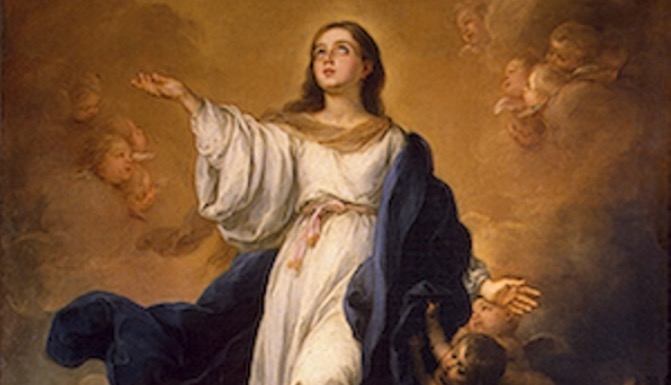The Feast of the Immaculate Conception: A Celebration of Purity and Grace

SHARE
The Feast of the Immaculate Conception, celebrated on December 8th, holds a special place in the hearts of millions around the world.
This solemn feast is not to be confused with the conception of Jesus Christ, but rather, it commemorates the immaculate conception of the Virgin Mary.
Rooted in centuries of tradition and religious significance, this day is observed with reverence and joy by the Catholic Church and various Christian denominations.
Theological Significance:
At the core of the Feast of the Immaculate Conception lies a theological belief that Mary, the mother of Jesus, was conceived without the stain of original sin. This means that from the moment of her conception, Mary was preserved by divine grace, ensuring her purity and holiness. The doctrine of the Immaculate Conception was officially declared a dogma of the Catholic Church by Pope Pius IX in 1854, solidifying its theological importance.
In the Philippines, this sacred feast is a holy day of obligation for Catholics, and attending mass is a tradition. The devotion to the Immaculate Conception began on February 6, 1578, when Pope Gregory XIII ordered that the Manila Cathedral in Intramuros be established under the title “Shrine of the Immaculate Conception.”
Another one, according to what Pope Paul VI wrote in “Marialis Cultus” (Culture of Mary), Mary is loved by God for the benefit and goodness of humanity. The importance of the dogma of the Immaculate Conception increased with the apparition of Our Lady of Lourdes on February 11, 1858, to St. Bernadette.
Biblical Basis:
While the term “Immaculate Conception” does not explicitly appear in the Bible, its roots are found in various biblical passages. One key reference is in the Book of Genesis (3:15), where God declares enmity between the serpent and the woman. Many interpret this as a prophecy of Mary’s role in salvation, as she would be the one to bear the Redeemer, Jesus Christ, and consequently, be preserved from the effects of original sin.
Celebrations Around the World and in the Philippines:
The Feast of the Immaculate Conception is celebrated with great fervor in numerous countries, each infusing its own cultural and regional traditions into the festivities. In countries like Spain, Italy, and the Philippines, vibrant processions, religious ceremonies, and festive events mark the day. In the United States, it is a holy day of obligation, with many attending special Mass services and participating in parades.
In the Philippines, part of the celebration involves holding masses in churches. There is also a procession featuring images of the Immaculate Conception, with students, members of various religious organizations, and devotees of the Virgin Mary participating. In Intramuros, a highlight of the celebration is the Grand Marian procession held on Sundays, showcasing more than a thousand images of the Blessed Virgin.
Photo courtesy: Pixabay
The feast has been declared a special non-working holiday in the Philippines, in accordance with Republic Act No. 10966. Related to this, Philippine President Ferdinand “Bongbong” Marcos, Jr. conveyed a message to all Catholics.
“On the Feast of the Immaculate Conception of Mary, let us embrace the virtues of purity, modesty, and faith,” he stated on his Facebook post.“We pray for continued hope and divine guidance in building the Bagong Pilipinas that we aspire for.”
Symbols and Traditions:
White is the traditional liturgical color for the Feast of the Immaculate Conception, symbolizing purity and innocence.
Images and statues of the Virgin Mary often depict her with a halo of stars, emphasizing her celestial grace. Many Catholic churches hold special novenas, prayer services, and the recitation of the “Ave Maria” (Hail Mary) in honor of Mary’s immaculate conception.
Impact on Art and Culture:
The Feast of the Immaculate Conception has inspired countless works of art throughout history. Renowned artists like Leonardo da Vinci, Diego Velázquez, and Bartolomé Esteban Murillo have depicted Mary in paintings and sculptures, capturing the ethereal beauty and grace associated with her immaculate conception.
These artistic representations have played a significant role in shaping the cultural understanding of this religious event.
Here in the Philippines, cities such as Antipolo City in Rizal, Naic in Cavite, Pasig City, Malabon City, Concepcion in Marikina City, Concepcion in Tarlac, and other towns celebrate the feast dedicated to the Virgin of the Immaculate Conception.
Furthermore, Catholic countries such as Spain, Portugal, and Brazil also celebrate the Immaculate Conception as a patronal feast. It is observed as a prime national holiday in Argentina, East Timor, Italy, Monaco, and Peru.
Conclusion:
The Feast of the Immaculate Conception stands as a testament to the deep-rooted faith and devotion of millions of believers worldwide.
Beyond its theological significance, the celebration serves as a reminder of the enduring cultural and artistic impact of this religious event.
As communities gather on December 8th to honor the purity and grace of the Virgin Mary, the Feast of the Immaculate Conception continues to weave its spiritual and cultural tapestry into the rich fabric of human history.
*Cover Photo/Thumbnail Photo from Opus Dei
RELATED ARTICLES

God’s Word on Caring for Animals That Bring You Gain

Generational Curses and Sirach’s View on Godless Offspring










